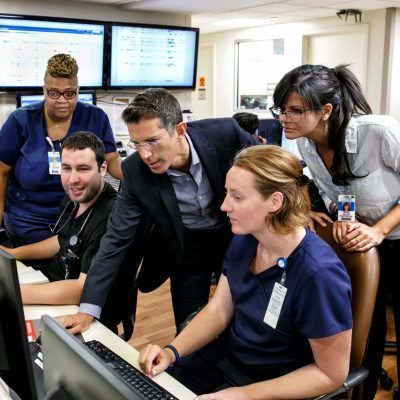The Chief of the Division of Ophthalmology at New York Methodist Hospital, on the vital role of his specialty and its synergistic relationship with other hospital departments
By megan schade
photos by amessé photography
Robert L. Feig, M.D., chief of the Division of Ophthalmology at New York Methodist Hospital
“The eyes, like sentinels, hold the highest place in the body.”–Cicero
The eyes look out from us, but they also look out for us. “Many people are surprised to learn that eyes are a very effective vehicle for monitoring, and sometimes even diagnosing systemic health conditions such as diabetes, hypertension, and cardiovascular disease,” says Robert L. Feig, M.D., chief of the Division of Ophthalmology at New York Methodist Hospital.
Ophthalmology is the science of the eye. It is a clinical specialty that straddles the knowledge and practice of both medicine and surgery. While optometrists provide eye exams and treat common eye issues such as conjunctivitis or dry eye, ophthalmologists are medical doctors who care for eye conditions that may require surgery and complex medical treatment.
Dr. Feig completed medical school and an ophthalmology residency at SUNY/Downstate Medical Center in Brooklyn, where he was chief resident. He continued his training with a fellowship in vitreo-retinal surgery at the University of Texas, Southwestern Medical Center, in Dallas.
In his practice, based in Park Slope, where he lives with his wife and two children, Dr. Feig diagnoses and treats retinal detachments, macular degeneration, cataracts, and all manner of other eye conditions, “but the majority of my practice involves caring for patients with eye diseases associated with diabetes,” he explained.
Diabetes is the leading cause of blindness, and greatly increases the risk of developing cataracts and certain types of glaucoma. The hyperglycemia of diabetes can damage the body’s blood vessels, including those in the eyes. Blood vessels in the eye may begin to leak fluid into the retina (the light sensitive tissue lining the back of the eye) resulting in a condition called diabetic retinopathy. At its simplest, retinopathy causes clouded vision, but it may also result in severe glaucoma and permanent vision loss.
“A patient who makes an appointment because of blurry vision may not even realize he or she has diabetes, let alone retinopathy,” said Dr. Feig. “But by examining the blood vessels in the eye, I can determine the reason for the blurriness, and encourage him or her to follow up with an endocrinologist for an evaluation. There is no cure for retinopathy, but advanced laser treatments and medication can prevent further damage and even restore vision.”
Glaucoma and cataracts are also ocular conditions associated with diabetes. While diabetes increases the risk of developing glaucoma and cataracts, the conditions can also affect people with no history of diabetes.
Glaucoma is an umbrella term for a group of diseases that damage the optic nerve by creating an increase in the eye’s fluid pressure. Diabetic retinopathy may affect the flow of the fluid, resulting in buildup and excessive pressure on the optic nerve. There is no cure for glaucoma, but interventions such as anti-inflammatory injections, eye drops, and surgery can reduce excess fluid, relieve pressure, and slow the disease’s advance.
Cataracts—clouding of the eye’s lens tissue—usually occur from direct damage to the lens or from the wear and tear of aging. People with diabetes have an increased risk of cataracts because increased sugar levels cause the lens to swell and become more opaque. Cataracts can be treated with routine outpatient surgery, during which the damaged lens is replaced with a new, synthetic lens.
“When I am not seeing patients in the office setting or performing surgery,” Dr. Feig said. “I am in the Hospital’s neonatal intensive care unit [NICU]. Some people are surprised to learn that ophthalmology is an important component of neonatal care, but the leading cause of vision loss in premature babies is a condition called retinopathy of prematurity. It is not uncommon for babies born before 32 weeks of gestation to have underdeveloped blood vessels in the eyes. As the vessels develop, they might not grow into the retina normally, resulting in retinal detachment and blindness. In the NICU, I screen all babies born before 32 weeks of gestation. If the retina is in danger of detaching, I can immediately use laser therapy to treat the abnormal retina and help prevent retinal detachment and vision loss.”
Another location where an ophthalmologist’s eyes are needed is in the NYM Emergency Room.
“In the ER, we see a pretty astounding array of cases that involve the eye,” said Joseph Bove, M.D., chairman of emergency medicine. “Everything from acute glaucoma and conjunctivitis to ruptured eye globes and orbital fractures makes an appearance. It isn’t like Hollywood, where you get punched in the face and you’re fine the next day. Any damage to the face affects the eye, and the eye is fragile. We need an ophthalmologist to evaluate the eyes for damage, and, if necessary advise a plan of treatment. The ophthalmologist is a crucial member of our ER team.”
“I enjoy working with the eye because I am able to provide relief and improve quality of life for my patients—usually within a fairly short time frame,” added Feig. “I love Brooklyn, my family has lived here for years, my wife had our daughter at New York Methodist, and I want to serve this community and the borough. The most important and engaging part of this field for me isn’t just the treatment, it’s the people. My patients are as varied as the conditions they come in with, and I wouldn’t have it any other way.”
New York Methodist Hospital
506 6th Street / 718.780.3000 / nym.org




